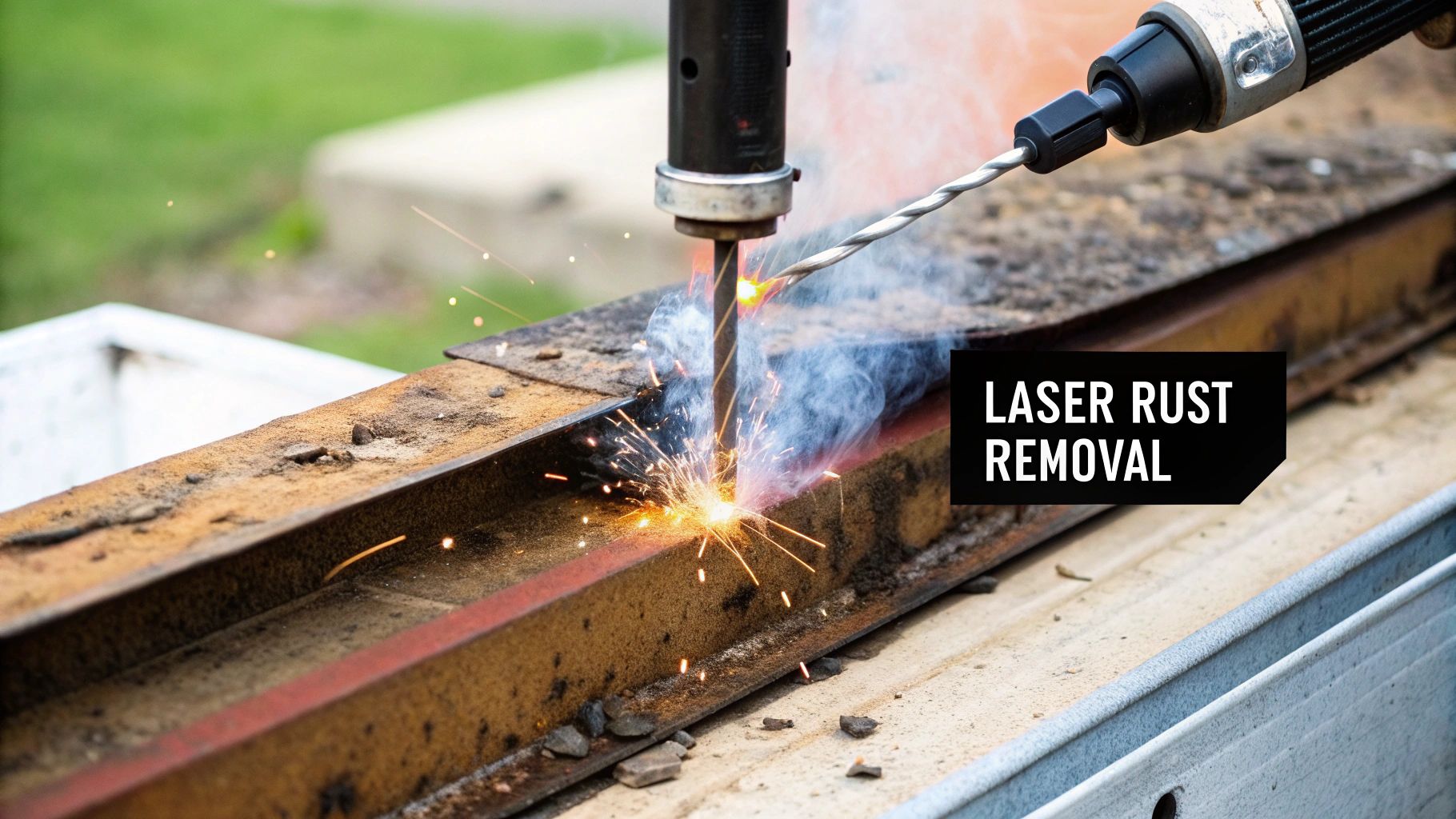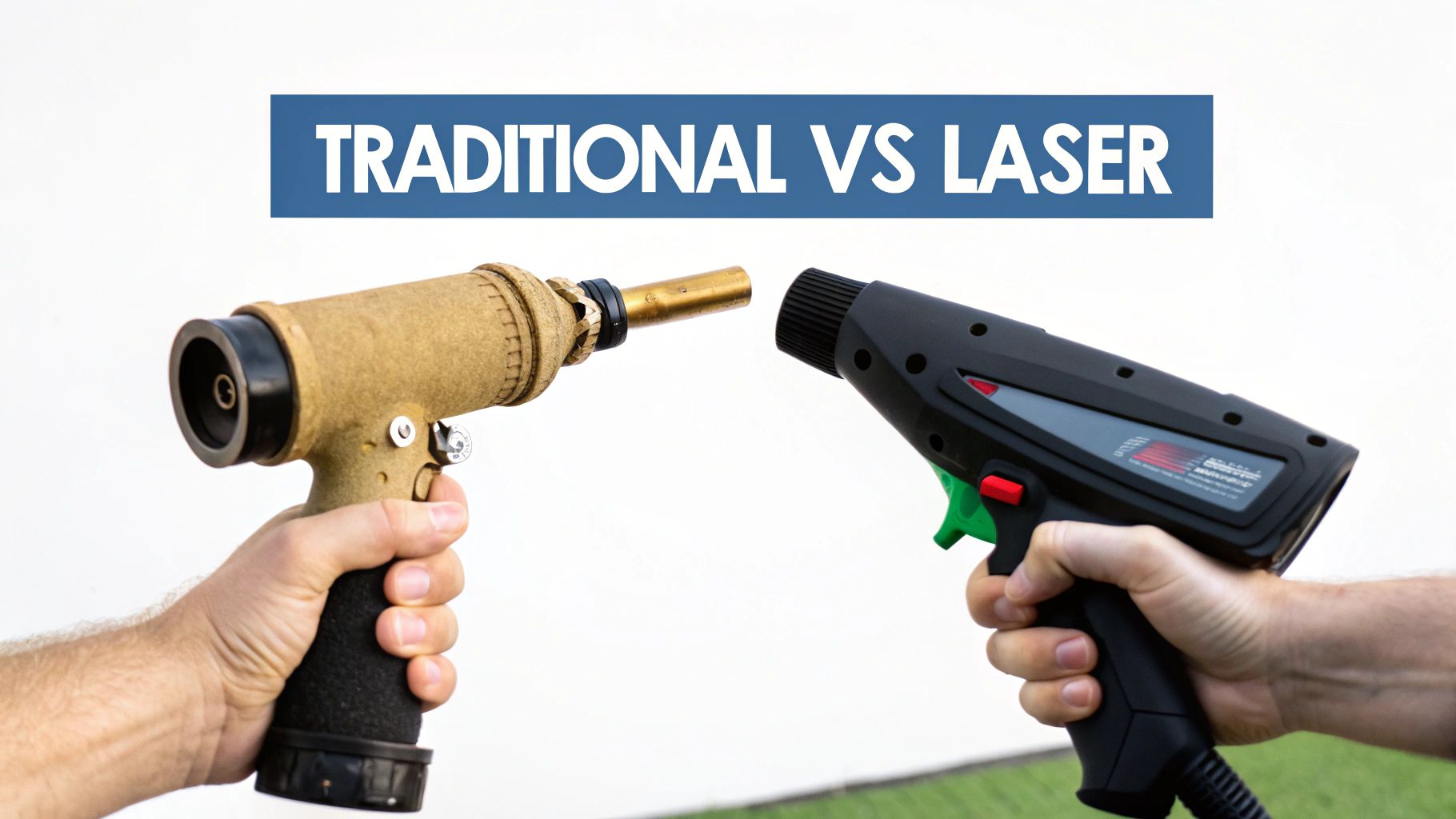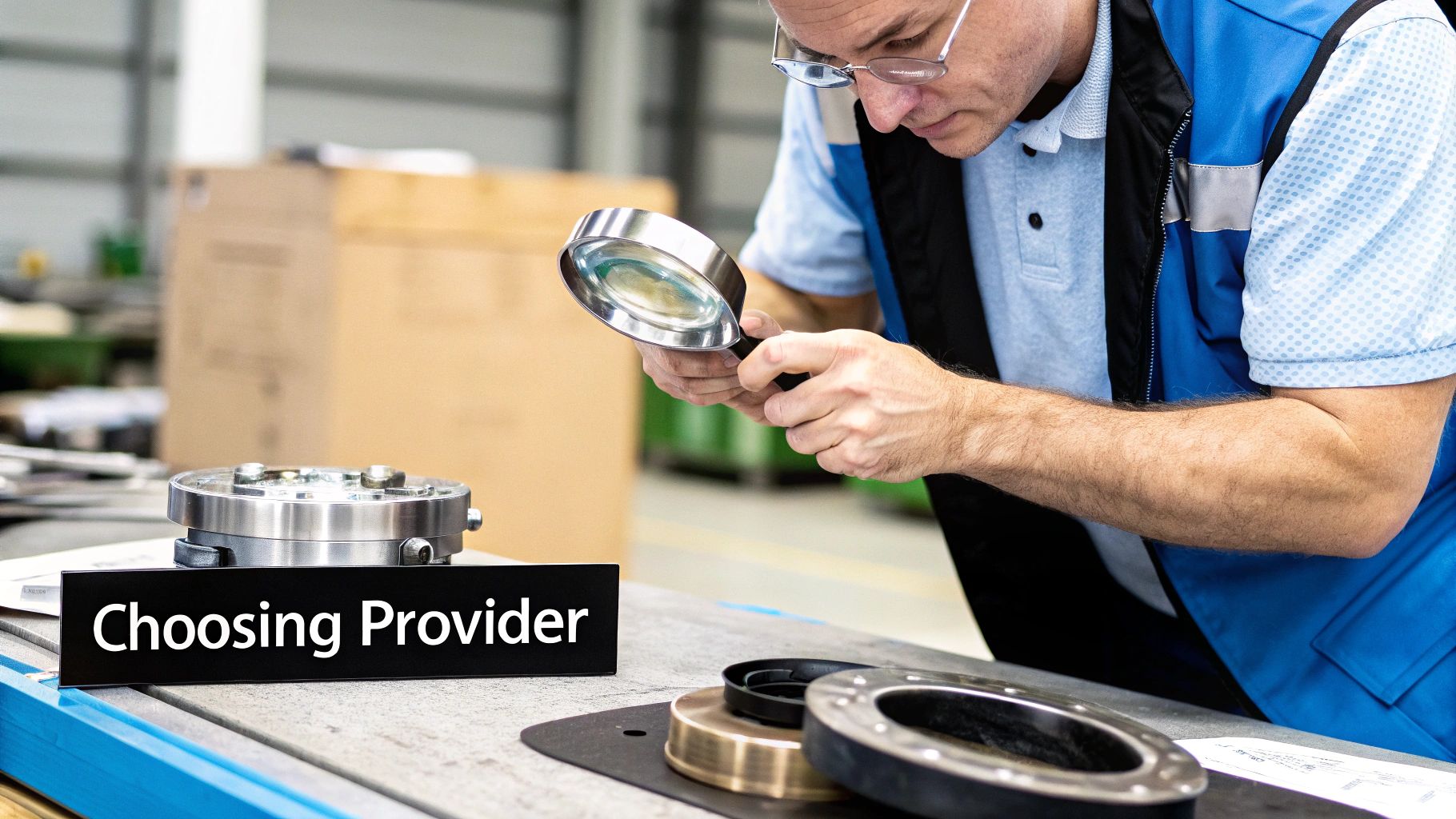Laser Rust Removal Cost in California | Find Out More
- Laserverse

- May 23
- 11 min read
The Science Behind Laser Rust Removal Technology

Laser rust removal relies on the principle of laser ablation. This process uses a focused beam of light energy to remove unwanted material from a solid surface. It precisely targets rust with intense heat, vaporizing it into a gas that dissipates without harming the underlying material. This precision distinguishes laser rust removal from traditional methods like abrasive sandblasting, which can damage the base material. For a more in-depth look at the process, check out this article: How does laser cleaning work?
How Does Laser Ablation Work?
The effectiveness of laser ablation hinges on the concept of ablation thresholds. Different materials require different energy levels to vaporize. Rust has a lower ablation threshold than metal. This allows a laser to be calibrated to vaporize the rust without affecting the underlying metal. Think of it like melting icing off a cake with a tiny, hot flame, leaving the cake perfectly intact. This controlled energy application allows for precise and efficient rust removal.
The Advantages of Laser Precision
The precision of laser rust removal makes it extremely effective for various applications, particularly in California. Delicate parts, intricate designs, and even valuable historical artifacts can be cleaned safely and effectively.
Laser rust removal is also environmentally friendly. Unlike traditional methods, it doesn't create harmful dust or chemical waste, making it a safer option for both workers and the environment.
The cost-effectiveness of laser rust removal compared to traditional methods is another factor influencing its adoption in California. While traditional methods are often cheaper upfront, laser rust removal offers greater precision and cleanliness, reducing waste and environmental concerns. This market research offers a detailed analysis of the current market.
While laser equipment can be more expensive to maintain, the enhanced efficiency and safety benefits make it an appealing option for California industries looking to modernize. When considering the financial implications, exploring alternatives like leasing can be beneficial. Comparing costs with other significant investments, like outlined in this article: How Much Does It Cost To Learn To Fly A Plane, can provide perspective. Understanding the science behind laser rust removal is vital for assessing whether its advantages outweigh the cost.
Breaking Down Equipment Costs By Power Category
Laser rust removal cost is a significant factor for California businesses considering this technology. Understanding the relationship between equipment power and price is crucial for informed decisions. This section explores the various power categories available and their associated costs, helping you choose the right equipment for your specific needs.
Power Categories and Their Applications
Choosing the right laser power is essential for effective rust removal. Different power levels cater to varying rust severities, surface areas, and desired cleaning speeds. Investing in an overly powerful system can strain your budget, while a less powerful machine might not deliver the desired results.
Low Power (50-200W): These entry-level systems are ideal for small-scale projects, detailed work, and light rust removal. They are a good option for hobbyists or small businesses in California seeking a cost-effective solution.
Mid-Range Power (300-500W): This category balances performance and cost, making it suitable for most industrial applications in California. These machines can handle moderate rust levels and larger surface areas.
High Power (1000W+): Designed for large-scale industrial applications, high-power systems offer rapid rust removal and high efficiency. These are typically used in large manufacturing or restoration facilities across California.
In California, the cost of laser rust removal equipment varies considerably. Entry-level systems (50-200W) can range from $5,600 to $9,800, while mid-range machines (300-500W) typically cost between $10,800 and $16,000. High-end systems (1000W+) can cost from $3,800 to over $18,000, a substantial investment for top-tier equipment. More detailed statistics can be found here.
To help illustrate the costs and capabilities of different laser rust removal equipment, the following table provides a comparison based on power range:
Laser Rust Removal Equipment Cost Comparison by Power Range This table compares the costs, capabilities, and ideal applications for different power categories of laser rust removal equipment available in California.
Power Category | Power Range | Price Range | Ideal Applications | Removal Speed | Best For |
|---|---|---|---|---|---|
Low | 50-200W | $5,600 - $9,800 | Small-scale projects, detail work | Lower | Hobbyists, small businesses |
Mid-Range | 300-500W | $10,800 - $16,000 | Moderate rust, larger areas | Medium | Industrial applications |
High | 1000W+ | $3,800+ | Large-scale industrial applications | High | Large manufacturers |
This table clearly shows how power and price correlate, with higher power generally commanding a higher price tag. It also highlights the best applications for each category, guiding businesses towards the most suitable choice.
Cost Per Square Inch Based on Rust Severity
The cost of laser rust removal isn't solely determined by the equipment; it also depends on the rust's severity. Heavier rust requires more laser power and time, leading to higher costs. The following infographic illustrates the average cost per square inch for different rust severities:

As the infographic demonstrates, the cost per square inch increases with rust severity. Light rust removal averages between $0.05 and $0.10 per square inch, while medium rust falls between $0.10 and $0.20. Heavy rust removal can reach $0.20 to $0.30 per square inch. This emphasizes the importance of early rust intervention to minimize costs.
Long-Term Operational Costs
Beyond the initial equipment investment, it's essential to consider long-term operational costs. These ongoing expenses include maintenance, consumable parts (such as lenses and laser sources), electricity consumption, and potentially operator training.
Choosing the Right Power for Your Business
Selecting the right power category depends on your business needs and application. Assess your typical rust removal tasks, including the parts' size and complexity, the rust's severity, and your workload. For instance, a small automotive repair shop in Southern California might find a mid-range system sufficient, while a large shipbuilder in Northern California would likely require a high-power system. Careful evaluation ensures a cost-effective investment and maximizes your return.
Leading Manufacturers and Their Price Positioning

Not all laser rust removal systems are the same. For California businesses, understanding the leading manufacturers is key to a smart investment. This means looking past the initial price tag and considering factors like the underlying technology, available support, and overall value.
Trumpf: Precision and Versatility
Trumpf is a respected name in the laser industry, known for its high-quality and adaptable systems. The TruMark and TruMicro series are common choices for a variety of applications. These systems are built to handle even the most stubborn rust and dirt, providing a durable solution for challenging projects. Trumpf's emphasis on precision and its broad range of power options make it suitable for diverse industries.
Baison Laser: Innovation and Customization
Baison Laser has earned a reputation for its innovative approach to laser cleaning. They offer customization options, enabling businesses to tailor their equipment to their unique needs. This flexibility, coupled with competitive pricing, positions Baison Laser as a compelling option for California businesses seeking personalized solutions. This tailored approach can help businesses manage costs by selecting only the features they need.
The California laser rust removal market is significantly shaped by these prominent manufacturers. Companies like Trumpf and Baison Laser offer a diverse range of equipment, from low-power to high-power machines. Explore this topic further. While these advanced technologies offer substantial benefits, the investment can be significant for smaller businesses or startups.
To assist California businesses in navigating the selection process, the following table provides a detailed comparison of leading laser rust removal equipment manufacturers.
Leading Laser Rust Removal Equipment Manufacturers in California This table presents key information about the major manufacturers, their popular models, price ranges, and unique features that California businesses should consider.
Manufacturer | Popular Models | Price Range | Unique Features | Warranty | Support Quality |
|---|---|---|---|---|---|
Trumpf | TruMark Series, TruMicro Series | $50,000 - $200,000+ | High precision, versatile applications, wide range of power options | Typically 1-2 years | Excellent, global network |
Baison Laser | Various customizable models | $20,000 - $100,000+ | Highly customizable, competitive pricing, focus on innovation | Varies depending on customization | Good, growing network |
Other notable manufacturers | (Information for other manufacturers can be added based on available data) | (Price ranges for these manufacturers can be added based on available data) | (Specific unique features for these manufacturers can be added based on available data) | (Warranty information for these manufacturers can be added based on available data) | (Support quality information for these manufacturers can be added based on available data) |
This table highlights key differences in price, features, and support offered by major manufacturers. Trumpf generally commands a higher price point reflecting its reputation for high precision and a comprehensive support network. Baison Laser offers more competitive pricing and customization options. Considering these factors can help businesses choose the best fit for their needs and budget.
Choosing the Right Manufacturer
Selecting the right manufacturer is vital for long-term success. This goes beyond the initial cost and includes:
Warranty Terms: A strong warranty can significantly reduce the total cost of ownership. Look for manufacturers providing extensive coverage for parts and labor.
Support Network: Reliable support is crucial for minimizing downtime and resolving issues quickly. Prioritize manufacturers with a strong California presence for easy access to technical support and service.
Industry Applications: Different manufacturers excel in specific industry applications. Research brands that align with your specific requirements.
Considering Total Cost of Ownership
While the initial cost is a major consideration, it’s essential to assess the total cost of ownership. This includes:
Maintenance: Regular maintenance is essential. Factor in the cost of routine service, replacement parts, and potential repairs.
Training: Proper operator training is vital. Include the cost of training programs.
Consumables: Some laser systems require consumables like lenses and laser sources. Factor in their cost and replacement frequency.
By carefully evaluating these factors, California businesses can make smart decisions that optimize their investment and ensure long-term success. Choosing the right manufacturer and system is an investment in your business’s future.
The Hidden Costs of Laser Rust Removal Operations
Beyond the initial price tag of a laser rust removal system, California businesses need to factor in several operational costs that can significantly affect their overall spending. A clear understanding of these hidden costs is essential for a fair comparison between laser rust removal and more traditional methods.
Power Consumption and California's Electricity Rates
Laser rust removal machines, particularly high-powered models, demand a substantial amount of electricity. This translates to higher energy bills, especially in California, a state known for its high electricity rates. As an example, a 1000W laser running for 8 hours a day consumes 8 kWh of electricity. Considering California's average commercial electricity costs, this can quickly become a considerable expense.
Maintenance and Component Lifespan
Just like any advanced piece of machinery, laser rust removal equipment requires consistent maintenance. This includes routine cleaning, inspections, and the inevitable replacement of parts like lenses and laser sources. Component lifespans vary, but lenses generally need replacing every 1,000-2,000 hours of use, while laser sources last considerably longer, around 10,000-20,000 hours. These replacement costs are an important part of the total cost of ownership.
Operator Training and Labor Costs
Trained operators are vital for safe and efficient laser rust removal. Training programs can last several weeks and involve associated expenses. Furthermore, skilled laser operators in California earn competitive wages, particularly in industrially active areas such as Los Angeles and the Bay Area. This labor cost adds another dimension to the overall operational expenses.
Additional Operational Costs
Beyond the primary cost factors, other expenses warrant consideration:
Facility Modifications: Depending on the laser equipment's size and type, facility adjustments may be necessary. This might involve electrical system upgrades and improvements to ventilation systems.
Safety Equipment: Laser safety glasses and other personal protective equipment (PPE) are essential for operator safety and contribute to ongoing costs.
Waste Disposal: Although laser rust removal produces less waste than traditional methods, the resulting vapor and particulate matter often require specialized disposal procedures, particularly given California's stringent environmental regulations. Further information can be found here: Industrial laser cleaning.
Insurance: Insurance premiums for laser equipment and operations can be substantial.
Understanding Total Cost of Ownership
By acknowledging these often overlooked costs, California businesses can make well-informed decisions about laser rust removal. A thorough calculation of the total cost of ownership, including the initial investment, operational expenses, and potential savings from improved efficiency and reduced waste, is essential to determine the true cost-effectiveness of this technology. This transparent cost analysis empowers businesses to compare laser rust removal with other methods and make strategic investments aligned with their long-term objectives.
When Does Laser Rust Removal Actually Pay Off?

For California businesses, the question of return on investment (ROI) is key when considering laser rust removal. Several factors influence the answer, and understanding these elements helps determine when this technology becomes a profitable investment.
Production Volume and ROI
One primary factor is your production volume. High-volume operations, such as busy auto restoration shops in Los Angeles, benefit significantly from the speed of laser rust removal. The quicker turnaround times translate directly into increased revenue and a faster ROI. Conversely, businesses with lower volumes may experience a longer period before recouping the initial investment.
Service Rates and Profitability
Your service rates directly impact profitability. Businesses charging premium prices for the high-quality results of laser cleaning, like specialized restoration services in San Francisco, will see a quicker return. Higher profit margins accelerate the break-even point and offset the initial cost of the laser system.
Efficiency Gains and Competitive Advantage
Efficiency gains from laser rust removal can create a competitive edge. For example, a manufacturing plant in Oakland might reduce downtime through faster rust removal. This increased productivity boosts profits and shortens the ROI timeline.
California-Specific Considerations
Several California-specific factors influence the cost-effectiveness of laser rust removal:
Environmental Compliance Savings: Stricter regulations make traditional methods, with their waste disposal costs, more expensive. Laser rust removal, a cleaner process, offers substantial savings. Waste disposal, including container usage, can contribute to hidden costs. For more information on waste disposal considerations, see this resource on Disposable Food Containers.
Worker Safety Regulations: Stringent worker safety regulations in California increase the costs of traditional rust removal due to necessary safety precautions. Laser rust removal’s inherent safety features mitigate these expenses.
Regional Industry Demands: Industries like aerospace and high-tech manufacturing in Silicon Valley require precision cleaning. This makes the quality and speed of laser rust removal particularly valuable, justifying the initial investment. Learn more about specialized Rust Removal Services.
Transforming Rust Removal into Revenue
Beyond cost savings, laser rust removal can create new revenue streams. A mobile restoration service could expand into historic building preservation, utilizing the technology's ability to clean delicate surfaces. This not only recoups the initial investment but also broadens market reach and profitability. Careful consideration of these factors allows California businesses to assess the financial implications of laser rust removal and make strategic investments aligned with their long-term goals.
Buying Vs. Hiring: Making the Smart Financial Choice
Deciding between purchasing a laser rust removal system and hiring a professional service in California requires careful financial planning. This section explores the costs associated with both options, helping you make the best decision for your specific circumstances.
Professional Laser Rust Removal Service Costs in California
Understanding current market rates for laser rust removal services in California is crucial. Pricing generally falls into three categories:
Hourly Rates: Contractors often charge hourly rates for smaller projects or specialized work. In California, these rates typically range from $75 to $150 per hour, depending on the provider's experience and the project's complexity.
Project-Based Pricing: A fixed price is common for well-defined projects. This offers budget predictability and simplifies the process.
Square Footage Rates: For larger areas, such as industrial cleaning, pricing is often calculated per square foot. Rates generally range from $0.50 to $2.00 per square foot, influenced by factors like rust severity and accessibility.
When Hiring Makes Financial Sense
Hiring a professional service often proves most cost-effective in the following situations:
Infrequent Rust Removal Needs: If rust removal isn't a regular necessity, hiring avoids the substantial investment of purchasing equipment.
Specialized Expertise Required: Complex or delicate projects might demand specialized tools and expertise best handled by seasoned professionals.
Access to Advanced Equipment: Contractors often invest in state-of-the-art technology, granting you access to equipment beyond your budget.
The Advantages of Owning a Laser Rust Removal System
While hiring provides flexibility, owning a laser rust removal system offers distinct benefits:
Control and Availability: In-house equipment eliminates scheduling conflicts and allows for immediate rust removal when necessary. This is particularly advantageous in time-sensitive production environments.
Potential Long-Term Cost Savings: Businesses with frequent rust removal needs may achieve significant long-term cost savings by owning a system, as opposed to repeatedly hiring contractors.
New Revenue Streams: Owning equipment presents opportunities to provide laser rust removal services to other businesses, creating new income potential.
Equipment Rental: A Middle-Ground Solution
Renting laser rust removal equipment offers a compromise between outright purchasing and hiring. Typical rental rates in California fall between $500 and $1,500 per day, depending on the equipment’s power and features. Before renting, consider the following:
Rental Duration and Cost: Assess the total rental cost against your project timeline and budget.
Equipment Suitability: Verify that the rented equipment meets your specific requirements regarding power, features, and portability.
Insurance and Liability: Understand the insurance coverage and liability terms outlined in the rental agreement.
By carefully evaluating these factors, California businesses can make informed decisions about whether to buy, hire, or rent laser rust removal equipment. The optimal choice depends on the frequency of use, necessary expertise, budgetary limitations, and long-term business objectives.
Ready to explore how Laserverse can meet your unique rust removal needs? Visit us to discover our advanced equipment, expert services, and tailored solutions.

